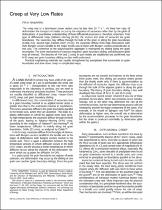JavaScript is disabled for your browser. Some features of this site may not work without it.
- ResearchSpace
- →
- Research Publications/Outputs
- →
- Journal Articles
- →
- View Item
| dc.contributor.author |
Nabarro, FRN

|
en_US |
| dc.date.accessioned | 2007-03-26T11:40:43Z | en_US |
| dc.date.accessioned | 2007-06-07T10:08:03Z | |
| dc.date.available | 2007-03-26T11:40:43Z | en_US |
| dc.date.available | 2007-06-07T10:08:03Z | |
| dc.date.issued | 2002-02 | en_US |
| dc.identifier.citation | Nabarro, FRN. 2002. Creep at very low rates. Metallurgical and Materials Transactions A, vol. 33(2), pp 213-218 | en_US |
| dc.identifier.issn | 1073-5623 | en_US |
| dc.identifier.uri | http://hdl.handle.net/10204/2055 | en_US |
| dc.description.abstract | The creep rate in a land-based power station must be less than 10(-11) s(-1). At these low rates of deformation the transport of matter occurs by the migration of vacancies rather than by the glide of dislocations. A quantitative understanding of these diffusional processes is, therefore, important. First type of diffusional creep (Nabarro-Herring (N-H)): the sources and sinks of vacancies are grain boundaries. The vacancies may diffuse through the bulk of the grain or along the grain boundaries (Coble (C)). Second type (Harper-Dorn (H-D)): the vacancies diffuse from edge dislocations with their Burgers vectors parallel to the major tensile axis to those with Burgers vectors perpendicular to this axis. The coherence of the polycrystalline aggregate is maintained by sliding along the grain boundaries. The three mechanisms of vacancy migration, grain boundary sliding, and dislocation glide may all interact. The theories of N-H and C creep in pure metals are established and confirmed, but H-D creep and grain boundary sliding are less well understood. Practical engineering materials are usually strengthened by precipitates that accumulate on grain boundaries and slow down creep in complicated ways. | en_US |
| dc.format.extent | 77368 bytes | en_US |
| dc.format.mimetype | application/pdf | en_US |
| dc.language.iso | en | en_US |
| dc.publisher | Minerals Metals Materials Society | en_US |
| dc.rights | Copyright: 2002 Minerals Metals Materials Society | en_US |
| dc.subject | Creep rates | en_US |
| dc.subject | Dislocations | en_US |
| dc.subject | Diffusional creeps | en_US |
| dc.subject | Mechanisms of vacancy migration | en_US |
| dc.subject | Materials sciences | en_US |
| dc.subject | Metallurgical engineering | en_US |
| dc.title | Creep at very low rates | en_US |
| dc.type | Article | en_US |
| dc.identifier.apacitation | Nabarro, F. (2002). Creep at very low rates. http://hdl.handle.net/10204/2055 | en_ZA |
| dc.identifier.chicagocitation | Nabarro, FRN "Creep at very low rates." (2002) http://hdl.handle.net/10204/2055 | en_ZA |
| dc.identifier.vancouvercitation | Nabarro F. Creep at very low rates. 2002; http://hdl.handle.net/10204/2055. | en_ZA |
| dc.identifier.ris | TY - Article AU - Nabarro, FRN AB - The creep rate in a land-based power station must be less than 10(-11) s(-1). At these low rates of deformation the transport of matter occurs by the migration of vacancies rather than by the glide of dislocations. A quantitative understanding of these diffusional processes is, therefore, important. First type of diffusional creep (Nabarro-Herring (N-H)): the sources and sinks of vacancies are grain boundaries. The vacancies may diffuse through the bulk of the grain or along the grain boundaries (Coble (C)). Second type (Harper-Dorn (H-D)): the vacancies diffuse from edge dislocations with their Burgers vectors parallel to the major tensile axis to those with Burgers vectors perpendicular to this axis. The coherence of the polycrystalline aggregate is maintained by sliding along the grain boundaries. The three mechanisms of vacancy migration, grain boundary sliding, and dislocation glide may all interact. The theories of N-H and C creep in pure metals are established and confirmed, but H-D creep and grain boundary sliding are less well understood. Practical engineering materials are usually strengthened by precipitates that accumulate on grain boundaries and slow down creep in complicated ways. DA - 2002-02 DB - ResearchSpace DP - CSIR KW - Creep rates KW - Dislocations KW - Diffusional creeps KW - Mechanisms of vacancy migration KW - Materials sciences KW - Metallurgical engineering LK - https://researchspace.csir.co.za PY - 2002 SM - 1073-5623 T1 - Creep at very low rates TI - Creep at very low rates UR - http://hdl.handle.net/10204/2055 ER - | en_ZA |






